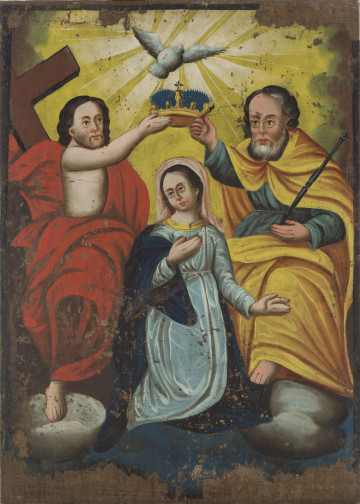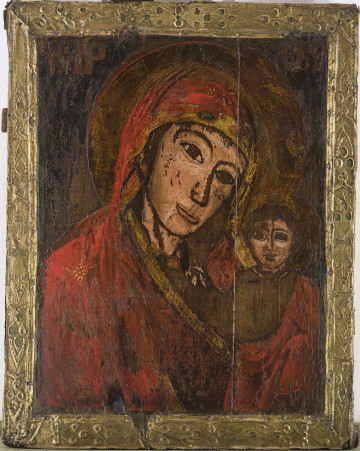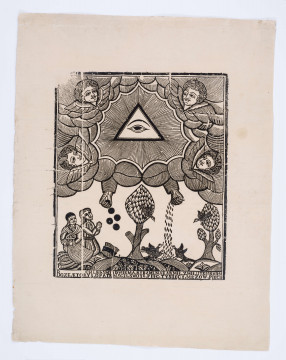
Coronation of the Virgin Mary (from the feretory)
1801 — 1900
National Museum in Lublin
Part of the collection: Folk Art of the Lublin Region (17th–1st half of the 20th c.)
The painting depicts God the Father supporting the tortured Christ on his knees (without any trace of wounds) and the Holy Spirit above them. Such a depiction refers to icon painting, which was common in Orthodox or Greek Catholic churches in the Lublin region, often standing next to Catholic ones. The kinship was indicated in the composition of the figures: elongated body proportions, faces with almond-shaped eyes and a long nose connected with one line with the eyebrows, as well as the contouring of the figures and richly decorated robes.
Until the 12th century, Trinitarian representations with such an iconographic formula were unknown in art. In the first centuries of Christianity, signs-figures, symbols or monograms were used to express the three Divine Persons. In the 10th century, the Trinity began to be depicted as three identical figures (sometimes angels) or three silhouettes of heads. During the late Middle Ages, in late Romanesque and Gothic art, images called the Throne of Grace (Tronus Gratiae, a term introduced into art at the end of the 19th century) were common, depicting a throning Father holding a cross with a dead Son before him. Around 1200, an image of the Holy Trinity was created, in which God the Father no longer holds the horizontal beam of the crucifix, but the outstretched hands of Christ taken down from the cross. It was an intermediate form between the Throne of Grace and the so-called Mercy of the Lord (Pietas Domini, Pietas Patris), depicting God supporting the Saviour's tortured body on his knees, with the Holy Spirit hovering over them in the form of a dove.
From the mid-14th century, the depiction of a pieta with the image of Mary and the dead body of Jesus Christ on her lap became more popular.
Author / creator
Dimensions
cały obiekt: height: 78 cm, width: 95 cm
Object type
picture
Technique
oil technique
Material
canvas, oil-based paint
Creation time / dating
Creation / finding place
Owner
The National Museum in Lublin
Identification number
Location / status

1801 — 1900
National Museum in Lublin

1801 — 1900
National Museum in Lublin

1901 — 1921
National Museum in Lublin
DISCOVER this TOPIC
Museum of King Jan III's Palace at Wilanów
DISCOVER this PATH
Educational path